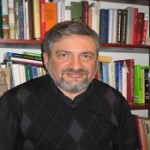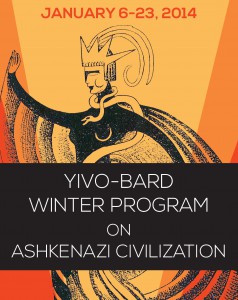Jewish Literary Life in the Soviet Union: Interview with Gennady Estraikh
 Gennady Estraikh
Gennady EstraikhGennady Estraikh is an expert on Yiddish literary and intellectual history, particularly of the Soviet era. He teaches at New York University, where he is the Rauch Associate Professor of Yiddish Studies, in the Skirball Department of Hebrew and Judaic Studies. He received his doctorate from Oxford in 1996, and is the author of Yiddish in the Cold War, and In Harness: Yiddish Writers’ Romance with Communism, among many other publications.
For this year’s YIVO-Bard Winter Program on Ashkenazic Civilization, Estraikh will teach the class, Jewish Literary Life in the Soviet Union, focusing on the lives and work of Soviet Yiddish writers from 1917 through 1991. The class will follow up on some of the major themes and ideas Estraikh introduced in his very popular 2013 Winter Program course, Jews in Soviet History.
Jennifer Young asked Estraikh about his years as a Yiddish refusenik, the literary differences between Kiev and Kharkov, and which Soviet Yiddish authors remain undiscovered gems for English-language audiences today.
JY: Your course, “Jewish Literary Life in the Soviet Union,” focuses on Yiddish writers from 1917 until 1991. That’s a significant timeline; because of the relatively constricted political and artistic freedoms in the Soviet Union over this period, are the writers in some ways similar to each other? Or do they find ways to create new sub-genres within their contexts?
GE: In the 1920s and 1930s, Yiddish writers concentrated in Moscow, Minsk, and Kiev (as well as Kharkov). In addition to the geographical divide, they also belonged to different currents – “proletarian” or those who continued the tradition of the Kiev Kultur-Lige. While the divide between “proletarian” and “non-proletarian” writers had almost disappeared in the second half of the 1930s, following the establishment of the Soviet Writers’ Union, geographical divides continued to play a significant role until the 1940s, when the Jewish Antifascist Committee emerged as the de facto umbrella organization for Yiddish writers, actors, and scholars.
In the 1950s-80s, the majority of Soviet Yiddish writers were products of pre-war Soviet Yiddish schooling. Their ranks were reinforced by cultural activists who lived in the Baltic countries, Poland or Romania and had become Soviet citizens only in 1939 or 1940, when those territories were annexed to the Soviet Union. Culturally and ideologically, these “westerners” were often a world away from their home-grown Soviet colleagues. In sum, the writers were people of rather different backgrounds, though the Soviet experience had created “common denominators” in their life and creative work.
JY: You were an editor of the Soviet literary journal, Sovetish Heymland (Soviet Homeland). What brought you to work there? Could you talk about your own personal background and how it affected your interest in Yiddish literature, both historical and contemporary?
GE: It can be told as a story of two visitors, who came to my home city of Zaporozhe (Ukraine).
In 1961, when I was 9, we had surprise visitors: the Yiddish writer Khaim Melamud. He and my father were called up on the same day in August 1941. The Melamuds came to Zaporozhe with an exciting piece of news: a Yiddish journal called Sovetish Heymland had been established in Moscow. I remember how happy my parents were when they got the first issue. They were also surprised that after not seeing a Yiddish text for so many years (their library had perished during the war) they initially found it somewhat difficult to read the journal. I also wanted to read it and easily learned the letters. In reality, I began to read the journal regularly and Yiddish books only in the late 1960s, when my father had cataracts in both eyes and asked me to read him periodicals and books.
Another surprise visitor, Comrade Gostinsky, gave one more strong impulse to my Yiddish interests. Gostinsky had illegally emigrated from Poland, studied in Moscow at the Yiddish Department of the Communist University of the National Minorities of the West. In 1937 he was arrested, allegedly as a Polish spy, and spent sixteen years in the gulag. In 1970 he came to Zaporozhe from the Siberian city of Novosibirsk, where he had settled after his liberation, to visit his friends. Significantly, Gostinsky’s old friends arranged for him subscriptions to the Warsaw Yiddish newspaper Folks-Shtime (People’s Voice) and the Parisian Communist Yiddish newspaper Di Naye Prese (New Press). He would peruse the newspapers and later mail them to my father. I also became an avid reader of the out-of-date issues.
When I moved to Moscow in the mid-1970s, I began to write to my parents in Yiddish. I concentrated on writing in Yiddish more seriously after becoming a refusenik in 1979 and, especially, after joining an unofficial group of young enthusiasts of Jewish scholarship. Paradoxically, this essentially dissident group, the Jewish Historical and Ethnographical Commission, was loosely linked with Sovetish Heymland, whose editor, Aron Vergelis, sought to attract young authors. To make a long story short, in 1988 I became the managing editor of the journal and worked on its staff during the heady perestroika years, until the summer of 1991, when I moved to Oxford.
JY: You remarked recently that you have noticed a psychological difference in teaching Yiddish literature today as opposed to 20 years ago; whereas even several decades ago, there was still a community of living Yiddish writers, today they have all passed away, and so teaching the literature feels different. Could you say more about this? Could we still have a Yiddish literary renaissance in the next 20 years?
 GE: You are right, I do feel a difference. In 1986, when my first stories appeared in Sovetish Heymland, I was considered a “young writer,” because at that time the literary landscape was populated by scores of well-established poets, prose writers and critics, who belonged to older generations. In the twenty-first century, the landscape has become depopulated or, to be precise, extremely underpopulated. As a result, the past tense dominates every Yiddish literary course.
GE: You are right, I do feel a difference. In 1986, when my first stories appeared in Sovetish Heymland, I was considered a “young writer,” because at that time the literary landscape was populated by scores of well-established poets, prose writers and critics, who belonged to older generations. In the twenty-first century, the landscape has become depopulated or, to be precise, extremely underpopulated. As a result, the past tense dominates every Yiddish literary course.
As for a renaissance, or a reappearance of the present tense in the coming years, I am not sure it is going to happen. I’ve been hearing about a renaissance of Yiddish and Yiddish culture since 1980s. Indeed, there are many enthusiasts, committed and talented people, but somehow it has not taken a shape of a renaissance. Some people believe that a new generation of writers will come from the ultra-orthodox milieu. I remain skeptical about it. In fact, there are ultra-orthodox Yiddish “belletrists,” but their writings have nothing to do with literature as we usually understand it. Most importantly, a century or so ago a departure from religious circles did not mean a departure from Yiddish, whereas nowadays it means a move to a world that speaks English, Hebrew, etc.
JY: What Soviet Yiddish writers do you think people should read today? Who in particular do you find most enduring or powerful?
GE: Few writers remain “readable” decades after their death. I call this process “minimization.” Only a handful of writers find a place in the minimized literary space. It is particularly hard to attract general readers’ interest to settings, such as shtetl or Soviet ones, which do not exist anymore. Still, pre-Soviet writings by David Bergelson and Der Nister have a kind of "connoisseur readership.” Such novels as Itsik Kipnis’s Khadoshim un teg (Months and Days) and Yoysef Rabin’s In yenem yor (In That Year) certainly deserve to be translated into English. Poetry was the strongest genre in Soviet Yiddish literature. Unfortunately, it is the least popular genre among contemporary readers.
JY: Who do you think will be most interested in taking your class? Who will get the most out of it?
GE: The writer vis-à-vis state power – this will be the central and, I believe, the most interesting theme that we’ll discuss in my class. No doubt, I’ll be the person who will get most out of it, because such classes help me improve my own understanding of Soviet Yiddish literary life.




